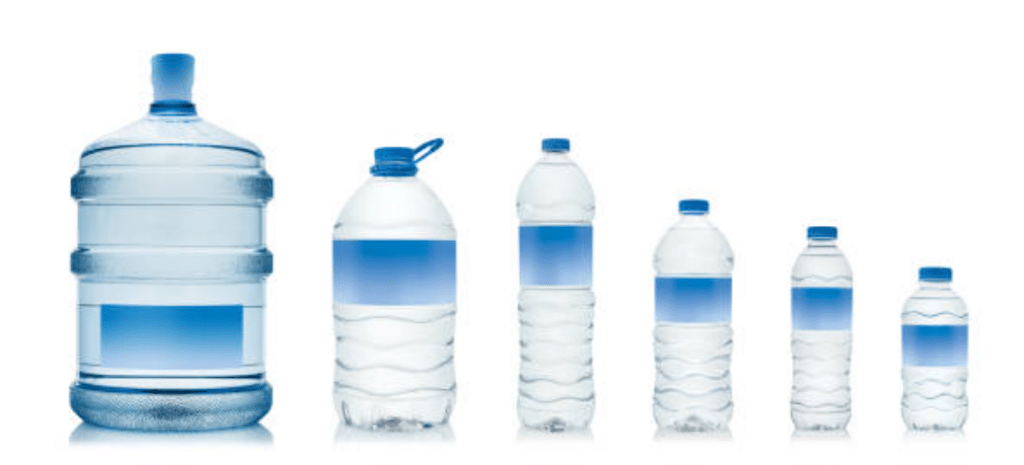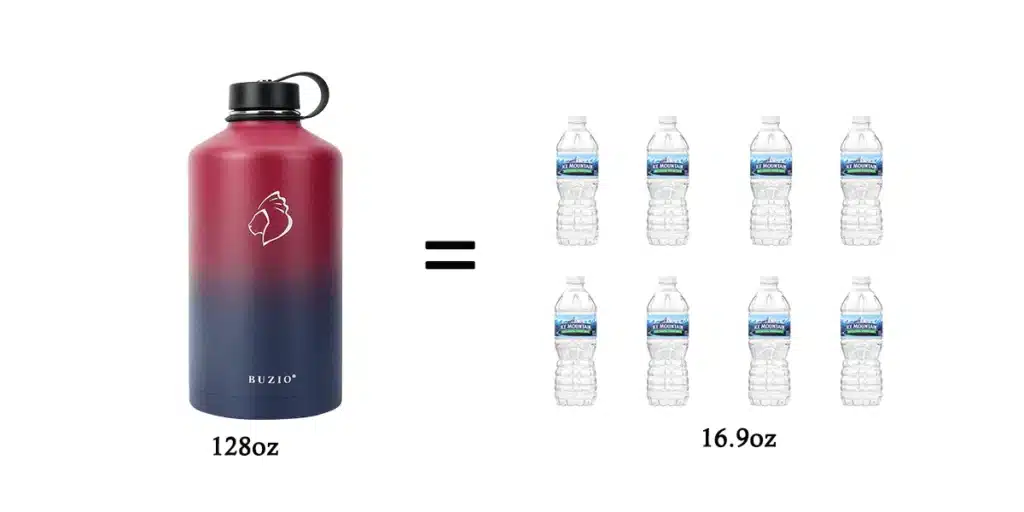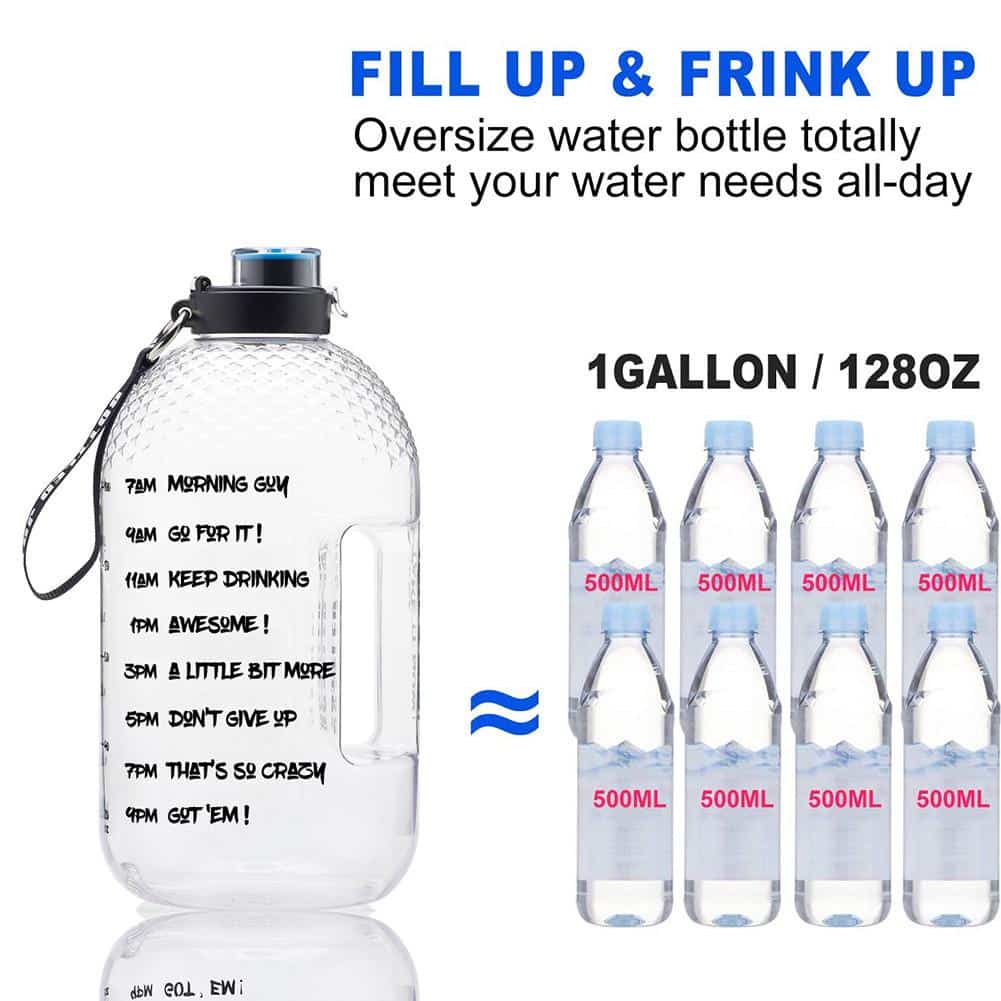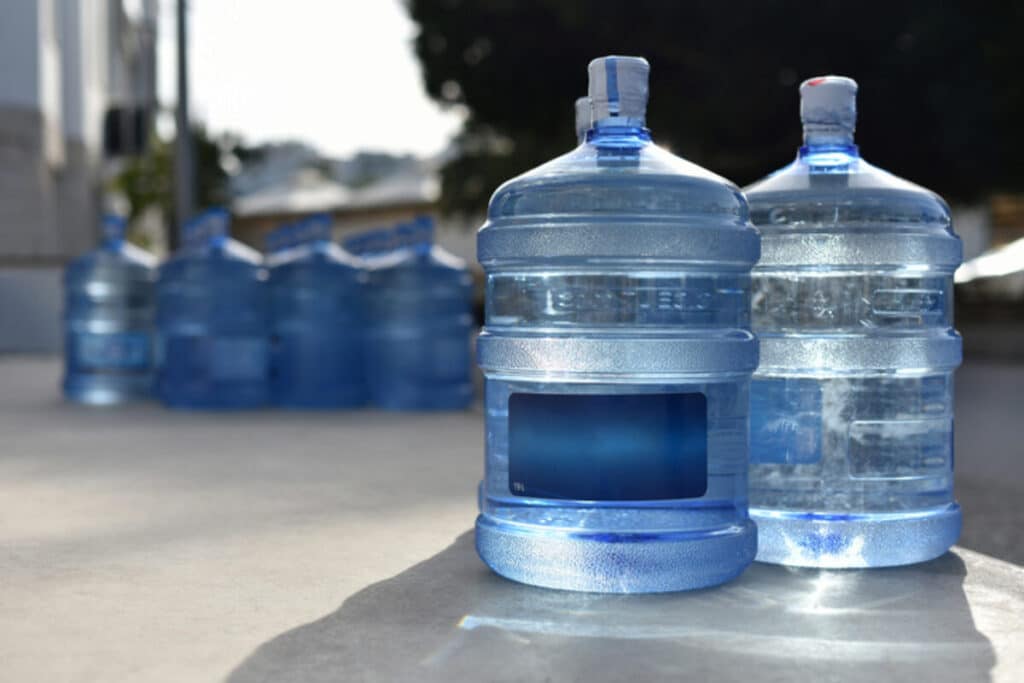How many bottles of water is a gallon? In your quest for staying hydrated and making environmentally conscious choices, you may often come across questions like.
Understanding this simple yet crucial conversion can help you manage your daily water intake more effectively and make informed decisions about the environmental impact of your hydration choices.
In this article, we will explore the relationship between water bottle sizes and the standard unit of volume, the gallon.
By delving into the conversion rate and the practical applications of this measurement, you can gain valuable insights into optimising your hydration routine while promoting sustainable practices. So, let’s dive in and uncover the answer to the common question: How many water bottles are there in a gallon?

SEE ALSO: How Many Pints Are in a Gallon? (Gallon to Pint Conversion)
What is a Gallon?
A gallon is a widely used unit of liquid measurement, equivalent to 128 ounces or 4 quarts. Visualizing it differently, one gallon of water can fill up 16 standard 8-ounce water bottles or be divided into four 1-quart containers. Regardless of the size or shape of the container used to measure it, a gallon of water will always hold the same amount.
SEE ALSO: How Many Steps in a Mile
How many bottles of water is a gallon?
It depends on the size of the water bottle. When talking about how many bottles of water are a gallon, assume an average-sized 16.9 fluid ounce (500ml) standard drinking water bottle. A gallon equals 128 fluid ounces, so it would take 7 and a half of these standard-sized bottles to make up one full gallon.
You can make simple calculations to find out how many standard water bottles are in one gallon. Since there are 128 fluid ounces in a gallon, and one water bottle contains 16.9 fluid ounces, divide the number of fluid ounces in a gallon by the number of fluid ounces in one water bottle. And this will give you approximately 7.57.
As finding a fraction of a bottle is impossible, you round the number to the nearest whole number, 8. Therefore, one gallon of water is approximately equal to 8 standard water bottles, with each bottle containing 16.9 fluid ounces or 500 millilitres. Be sure to keep in mind that the number of bottles in a gallon may differ depending on the bottle sizes.

SEE ALSO: How Many Cups in a Pint (Easy Conversion Charts)
Litres to Gallon Conversion
How many bottles of water a gallon can also be converted from litres to gallons? Litres are commonly used in Europe and other countries, which means it’s important to know how to convert them when necessary.
One litre is equal to 0.264172052 gallons, so if you need to calculate how many gallons are in a certain amount of litres, then you simply need to multiply the number of litres by 0.264172052. For example, 5 litres of water would equal 1.32086026 gallons or 13 and two-thirds bottles of water (assuming each bottle is 16.9 fluid ounces).
SEE ALSO: How Many Pints in a Quart? (Liquid Measurement)
How much does a gallon of water weigh?
It’s important to consider how much a gallon of water weighs when talking about how many bottles of water are in a gallon. A gallon of water typically weighs 8.34 pounds (or 3.78 kilograms), so if you are trying to calculate how heavy your load will be with a certain amount of bottles, then it’s important to consider how much a gallon of water weighs.
1 gallon = 16 x 8.45 fluid-ounce bottles or 128 fluid ounces
– 1/2 gallon = 8 x 8.45 fluid ounce bottles or 64 fluid ounces
– 1/4 gallon = 4 x 8.45 fluid ounce bottles or 32 fluid ounces
– 1 litre = 2.11 x 8.45 fluid ounce bottles or 17.7 fluid ounces
SEE ALSO: How Many Ounces in a Shot (Food Conversion Guide)
Importance of Bottle Measurement
The practical significance of water bottle sizes and measurements impacts various aspects of our daily lives and the environment:
- Hydration Management: Understanding water bottle sizes helps individuals track their daily water intake efficiently, promoting better hydration for overall health and well-being.
- Portion Control: Smaller water bottle sizes aid in managing fluid consumption throughout the day and support portion control for those mindful of their water intake.
- Convenience and Mobility: Different bottle sizes cater to diverse lifestyles and activities, with smaller bottles being convenient for short trips and larger ones suitable for sports or longer outings.
- Environmental Impact: Being aware of water bottle sizes contributes to reducing plastic waste, as smaller bottles generate less plastic consumption.
- Buying and Budgeting: Understanding water bottle sizes allows consumers to make informed choices when purchasing bottled water, comparing prices, and selecting the best fit for their needs.
- Emergency Preparedness: Knowing the number of smaller bottles required to reach a gallon helps individuals prepare and store adequate water supplies in emergencies.
- Travel and Storage: Choosing appropriate bottle sizes ensures ease of travel and storage, minimizing spills and inconvenience during trips.
- Promoting Reusability: Awareness of water bottle sizes encourages the use of reusable bottles, reducing plastic waste and promoting eco-friendly practices.

SEE ALSO: How Many Cups in a Litre? Quick Conversion Guide
Water Bottle Sizes
Water bottle sizes can vary depending on the brand, region, and intended use. Here are some common water bottle sizes found in the market:
- 8 fluid ounces (fl. oz): This small water bottle is often used for kids’ lunches or as a single-serving size for quick hydration on the go.
- 12 fluid ounces (fl. oz): A slightly more prominent option, commonly available in packs for convenience.
- 16.9 fluid ounces (fl. oz): This is a standard size for bottled water and is commonly sold in individual bottles or packs. It’s a popular choice for everyday use.
- 20 fluid ounces (fl. oz): A bit larger than the standard size, often chosen for longer outings or extended periods without water access.
- 1 litre (33.8 fluid ounces): Often packaged as a single-serving bottle, this size is commonly used in various beverages, including water.
- 1.5 litres (50.7 fluid ounces): A more significant option for individuals who need more water during the day or for sharing during outdoor activities.
- 2 litres (67.6 fluid ounces): Frequently used for bulk purchases or keeping a larger water supply home.
- 3 litres (101.4 fluid ounces) or 1 gallon (128 fluid ounces): These sizes are commonly used for storage or refilling smaller bottles.

SEE ALSO: How Many Teaspoons Are in a Tablespoon
How much water should I drink in a day?
The amount of water you should drink daily can vary depending on factors such as age, sex, activity level, climate, and overall health.
However, a common and widely recommended guideline is the “8×8 rule,” which suggests drinking eight 8-ounce glasses of water per day, totaling about 2 litres or half a gallon. This is easy to remember and a good starting point for most individuals.
However, it’s important to note that individual water needs can differ, and there is no one-size-fits-all approach. The National Academies of Sciences, Engineering, and Medicine provides more specific guidelines called the Dietary Reference Intakes (DRI) for water intake. According to their recommendations:
- Adult Men: The adequate intake (AI) for total water (from all beverages and food) is about 3.7 litres (or about 13 cups) per day.
- Adult Women: The AI for total water intake is about 2.7 litres (or about 9 cups) per day.

SEE ALSO: How Many Cups in a Pound
Tips for Staying Hydrated:
- Drink water throughout the day, not just when you feel thirsty.
- Carry a reusable water bottle with you to track your water intake and have water readily available.
- Drink water before, during, and after exercise.
- Consume water-rich foods, such as fruits and vegetables, which also contribute to your overall water intake.
- Pay attention to the colour of your urine; pale yellow or straw-coloured urine generally indicates adequate hydration.
SEE ALSO: How many Quarts in a Gallon (Food Measurements)
Conclusion
Understanding how many water bottles make up a gallon is important for daily hydration. By recognising that approximately 3.785 litres equal one gallon, you can easily determine the number of water bottles needed to reach this volume.
This knowledge also helps you to track your water intake more effectively, ensuring you stay adequately hydrated throughout the day.
Also, being aware of the various water bottle sizes available in the market helps you make informed choices based on your specific needs, whether it’s for convenient portability during short outings or for longer outdoor excursions requiring larger capacities.
Furthermore, the importance of this measurement extends beyond personal use. It plays a crucial role in promoting environmental sustainability. By understanding the relationship between gallons and water bottles, you can make conscious decisions to reduce single-use plastic waste by opting for reusable water containers.
Knowing how many water bottles are equivalent to a gallon helps you make smart choices for your well-being and the environment, ensuring that you stay hydrated while minimizing your ecological footprint.
SEE ALSO: How many Tablespoons in a Cup (convert tbsp to cup)
FAQs About Bottles of Water in a Gallon
Is 4 bottles of water a day a gallon?
The average 16-ounce (500ml) bottle of water contains 0.5 gallons, which is half of a gallon. That means that it takes 8 bottles to make up one gallon. If the bottle size is larger, such as a 20-ounce (600ml) bottle, then you would need 6 and two-thirds bottles of water to equal one gallon (6.67 bottles = 1 gallon)
How much water is 4 bottles a day?
We all know that we should drink eight glasses of water daily, and most prefer bottled water over tap water. A typical glass of water contains eight ounces, so ideally, we should each consume 64 ounces per day, equivalent to four bottles of water.
